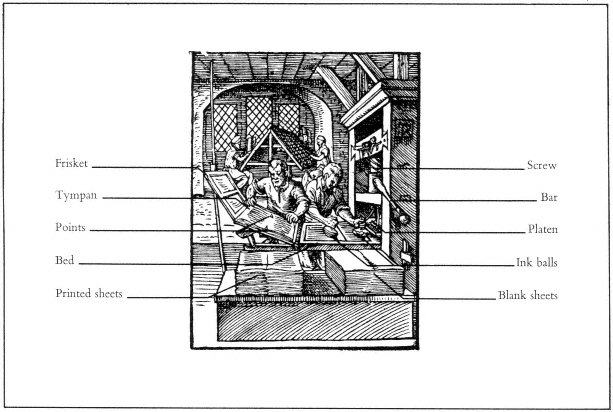Type Printing in the Fifteenth Century
Whether early interchangeable type characters in Europe were cast as flat metal plates or on more easily held shanks of about the 2.5 cm. height of modern types has long been a source of speculation. The method of holding a page of type together is also uncertain. There is a possibility that letters were composed and held in place in a metal tray or galley coated with beeswax and placed on the bed of the press. Heating the back of the galley would facilitate the removal or replacement of the characters.
A similar method appears to have been used in Korea from the eighth century on. Ancient Korean wood types, about 1.25 cm. high, survive They taper slightly from top to bottom, which would have permitted wax to push up between the letters when they were set in a wax-coated tray. The surfaces of the letters could then have been levelled by tapping with a block and mallet. This would have held them securely and compensated for differences in their heights. Such type forms still exist in the National Library in Seoul.[17] But as yet no evidence of the beeswax "lock-up" method of the fifteenth century has appeared in Europe. In Korea and China lines of type were known to be held together with thread, string, wire, or bamboo strips through holes in the bodies of the characters. In 1868 some metal type characters which had holes in the shanks were fished out of the Saône near Lyon. For a time it was believed this showed that the same tying-up method was used in Europe, but it was subsequently demonstrated that the holes were due to faulty casting.[18]
An ancient practice in the early printing houses was to wind twine around the sides of the whole page, as is done today for quick proofing and for storage. This method, if it was used for prototypography, would explain the sometimes irregular alignment of characters. It might also account for the upside-down line at the foot of a column in the second Dutch edition of the Speculum . The printer could have decided it was too much trouble to untie the form when, or if, the error was discovered. If the text was printed from cast metal plates, the line would have had to be sawed off, turned around, and remounted, no small task. However there is no evidence preserved of such plate casting.
We believe that individual characters on rectangular shanks, cast in adjustable molds, were used for the Speculum . As for the invention, the anonymous printer could have been experimenting concurrently with Gutenberg. History is full of independent discoveries in different
[17] T. F. Carter, The Invention of Printing in China and its Spread Westward , 2nd edition, revised by L. C. Goodrich (New York, 1955); see also Pow-key Sohn, Early Korean Typography (The Korean Library Science Research Institute, Seoul, 1971), p. 6. We are indebted to Muir Dawson of Los Angeles for the information about the type forms in Seoul.
[18] Sem L. Hartz, "Notes on the "Types Lyonnais Primitifs,'" in Quaerendo, IV, 4 (1974), pp. 285 ff.

V-13.
Wooodcut by Jost Amman, 1568, showing the use of ink balls, and the
tympan and frisket open.
places simultaneously, and movable type had reached its time.[19] The letters could have been fixed in a frame by the simple pressure principle of opposing wedges. Straight strips of wood and wider blocks placed between the wedges and the form would have filled out the frame. We know such strips were used in printing the Speculum , between the text columns, because on several pages they accidentally became inked and printed.
In the Jost Amman woodcut of an early press (fig. V-13) the major parts can be clearly seen. At the right, the surface of the type, on the bed of the press, is being coated by means of ink balls. In the center is the tympan, a frame stretched with paper or parchment. The printed sheet was correctly stationed by being pierced through points in the tympan. This is hinged to the press bed on one side and on the other to a frame called the frisket. Holes were to be cut into the sheet stretched across it, to expose the printing areas and mask out the blank spaces. The frisket was folded over the tympan and held the paper in place. Then both were folded onto the type form and all were pushed halfway beneath the press for printing the first page, and all the way for the conjugate page. One can see the bar at right which was pulled by hand and turned the screw to press down the platen and print the page. Sometimes the frisket was miscut and the characters used to fill out the type lines or column depths were also printed.
[19] Curt F. Bühler, "A Note on Zedler's Coster Theory," in The Papers of the Bibliographical Society of America, XXXVII (1943), pp. 67–68.